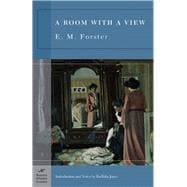From Radhika Jones’s Introduction to A Room with a View
Lucy comes of age, as Forster himself did, at a time of sea changes in Britain and the world: the ebb of British imperial power, the end of the Victorian era, the onset of the modern age, and the portents of a world war. It is a moment of epic transition signaled from the novel’s first page, when Forster turns our eye to the “portraits of the late Queen and the late Poet Laureate” that grace the dining room of the Pension Bertolini, reminding those present that the era of Victoria and Tennyson has passed irrevocably into history. But like those portraits, the historical transitions at work in A Room with a View act chiefly as backdrops for the deeply personal issues with which Lucy struggles. After all, Lucy is no revolutionary; she moves within the parameters of what is possible for a girl of her age and situation. What social boldness she has comes in spurts, often uncertain ones. She expresses herself most effectively in indirect ways, and not in words but in music, sitting at the piano. Confident in Beethoven, she is nevertheless hesitant without her Baedeker; her artistic connection to music does not manifest itself outside that medium. It is tempting to accept Mr. Beebe’s assertion that “if Miss Honeychurch ever takes to live as she plays, it will be very exciting—both for us and for her” as a formula for the novel, but Forster leaves us in doubt as to whether Lucy ever fulfills that potential; indeed, whether she ever could. The ending that awaited most literary heroines of the Victorian era—marriage—will be her ending too. Where she finds room to distinguish herself, to inhabit the freedoms of this age of transition, is in the manner of man she will marry, and that is where the energies of the novel are focused.
A Room with a View also inhabits an age of transition from the point of view of literature. The three-decker novel that had dominated the second half of the nineteenth century was now a dinosaur, virtually extinguished in the 1890s by the onset of cheap, one-volume editions, and its complex plots and sometimes belabored prose were giving way along with its physical bulk. Forster’s early novels demonstrate this shift in action. There is a casual quality to his prose that makes his novels themselves seem casually constructed, as if they were the natural result of recording experience on paper. The influential American critic Lionel Trilling, describing the “colloquial unpretentiousness” of Forster’s style, cites it as proof that Forster was “content with the human possibility and content with its limitations” (quoted in Wilde, ed., Critical Essays on E. M. Forster, p. 59). Unlike the writing of the high modernists (James Joyce, Virginia Woolf, D. H. Lawrence) who would make their mark in succeeding decades, Forster’s prose does not evince a formal struggle; it does not attempt to break free of perceived linguistic or semantic constraints. Not incidentally, it is not difficult to read. But it would be a mistake, on these grounds, to think of Forster as artless. A close look at the underpinnings of A Room with a View—its language, its motifs, its structure—shows a craftsman at work.
There is, first of all, the role of the narrative voice in absorbing and reflecting the novel’s themes through language. We might begin with the narrator’s treatment of Lucy, who is on the verge of learning to interpret the world and its inhabitants but often takes refuge in the opinions of others rather than attempt to puzzle things out on her own. In the first chapter, as she copes with the repressive Charlotte, the tactless Emersons, and the mildly interfering Mr. Beebe, she is described as “bewildered”; she “had the sense of larger and unsuspected issues” that she fails to identify, let alone resolve. Unable to determine what to make of the Emersons, she finally asks Mr. Beebe directly: “Old Mr. Emerson, is he nice or not nice? I do so want to know.” This perplexity, presented quite baldly by the narrator, is part of what makes Lucy convincing as a modern heroine: that she does not make any claims to being particularly heroic.
